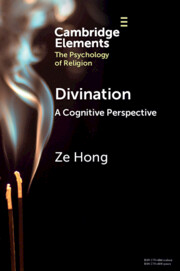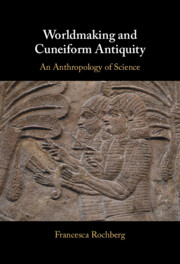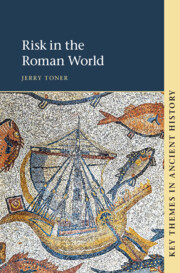Refine search
Actions for selected content:
58 results
Chapter 4 - Technical Divination and Mechanics of Sacred Space
- from Part II - Technologies and Ritual Experience
-
- Book:
- Technologies of the Marvellous in Ancient Greek Religion
- Published online:
- 04 September 2025
- Print publication:
- 24 July 2025, pp 105-124
-
- Chapter
-
- You have access
- Open access
- HTML
- Export citation
4 - Nahua Women Teach Iberian Women How to Cast Spells
- from Part II - Magic in the 1520s and 1530s
-
- Book:
- The Women Who Threw Corn
- Published online:
- 28 May 2025
- Print publication:
- 26 June 2025, pp 95-122
-
- Chapter
- Export citation

Divination
- A Cognitive Perspective
-
- Published online:
- 29 April 2025
- Print publication:
- 22 May 2025
-
- Element
-
- You have access
- Open access
- HTML
- Export citation
The seasonality of empire: Coping with the intermittence of the global in Portuguese Asia and beyond (1500–1650)
-
- Journal:
- Journal of Global History / Volume 20 / Issue 1 / March 2025
- Published online by Cambridge University Press:
- 18 February 2025, pp. 1-20
-
- Article
-
- You have access
- Open access
- HTML
- Export citation

Worldmaking and Cuneiform Antiquity
- An Anthropology of Science
-
- Published online:
- 09 January 2025
- Print publication:
- 09 January 2025
Lesser elite in crisis: family strategies of divination (yinyang) school instructors in the Yuan–Ming transition
-
- Journal:
- Journal of the Royal Asiatic Society / Volume 35 / Issue 1 / January 2025
- Published online by Cambridge University Press:
- 06 December 2024, pp. 97-109
- Print publication:
- January 2025
-
- Article
-
- You have access
- Open access
- HTML
- Export citation
20 - Creativity and Aesthetics
- from Part III - Colonial Societies
-
- Book:
- Understanding Colonial Nigeria
- Published online:
- 21 November 2024
- Print publication:
- 28 November 2024, pp 423-452
-
- Chapter
- Export citation
11 - Asian Goddesses and Bees
- from Part III - Anatolian and Aeolian Myth and Cult
-
- Book:
- Aeolic and Aeolians
- Published online:
- 21 November 2024
- Print publication:
- 21 November 2024, pp 317-343
-
- Chapter
- Export citation
Exploring the role of divination in traditional medicine in Africa: a critical perspective
-
- Journal:
- Research Directions: One Health / Volume 2 / 2024
- Published online by Cambridge University Press:
- 17 October 2024, e16
-
- Article
-
- You have access
- Open access
- HTML
- Export citation
6 - Law and Religion
-
-
- Book:
- The Cambridge Comparative History of Ancient Law
- Published online:
- 09 May 2024
- Print publication:
- 30 May 2024, pp 231-302
-
- Chapter
- Export citation
TWO ATTITUDES TO DIVINATION IN EUNAPIUS
-
- Journal:
- The Classical Quarterly / Volume 74 / Issue 1 / May 2024
- Published online by Cambridge University Press:
- 06 May 2024, pp. 379-380
- Print publication:
- May 2024
-
- Article
-
- You have access
- Open access
- HTML
- Export citation
14 - Religion
- from Part II - Contexts
-
-
- Book:
- The Cambridge Companion to Alexander the Great
- Published online:
- 04 January 2024
- Print publication:
- 18 January 2024, pp 226-242
-
- Chapter
- Export citation

Risk in the Roman World
-
- Published online:
- 16 November 2023
- Print publication:
- 30 November 2023
5 - Toward a New Prognosis
-
- Book:
- Prophets and Prophecy in the Late Antique Near East
- Published online:
- 26 October 2023
- Print publication:
- 09 November 2023, pp 197-230
-
- Chapter
- Export citation
Chapter 7 - Epiphany and Divination Reconsidered
- from Part II - Status, Role, and Functions of Human Intermediaries
-
-
- Book:
- Divination and Revelation in Later Antiquity
- Published online:
- 19 October 2023
- Print publication:
- 02 November 2023, pp 136-158
-
- Chapter
- Export citation
Chapter 5 - ‘The Holiest Man Ever Born’: Sages, Theioi Andres, and the Shaping of Late Greek Prophecy
- from Part II - Status, Role, and Functions of Human Intermediaries
-
-
- Book:
- Divination and Revelation in Later Antiquity
- Published online:
- 19 October 2023
- Print publication:
- 02 November 2023, pp 99-119
-
- Chapter
- Export citation
Chapter 2 - The Neoplatonic Background of a Text on Prophecy Attributed to John Chrysostom
- from Part I - Philosophical Perspectives on Divination, Revelation, and Prophecy
-
-
- Book:
- Divination and Revelation in Later Antiquity
- Published online:
- 19 October 2023
- Print publication:
- 02 November 2023, pp 32-48
-
- Chapter
- Export citation
Chapter 4 - Divination and Dialogue in Porphyry and Iamblichus
- from Part I - Philosophical Perspectives on Divination, Revelation, and Prophecy
-
-
- Book:
- Divination and Revelation in Later Antiquity
- Published online:
- 19 October 2023
- Print publication:
- 02 November 2023, pp 73-96
-
- Chapter
- Export citation
Chapter 6 - Women and Divine Dreams in Jewish Texts of the Greco-Roman Era
- from Part II - Status, Role, and Functions of Human Intermediaries
-
-
- Book:
- Divination and Revelation in Later Antiquity
- Published online:
- 19 October 2023
- Print publication:
- 02 November 2023, pp 120-135
-
- Chapter
- Export citation
23 - Precision and the Limits of Autopsy in Augustine’s Critique of Pagan Divination
-
-
- Book:
- The Intellectual World of Late Antique Christianity
- Published online:
- 05 October 2023
- Print publication:
- 26 October 2023, pp 426-442
-
- Chapter
- Export citation
